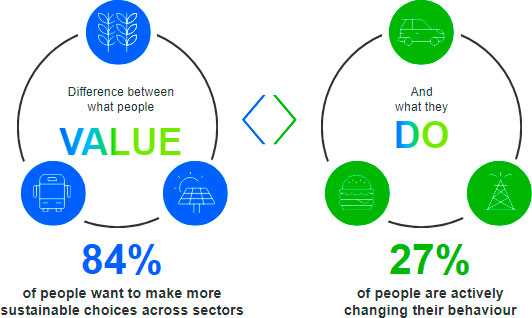.jpg)
For many years Kantar has been tracking consumer behaviour based on people’s social and environmental values. What we’ve consistently identified is that those values do not always translate into actions.

In 2024 we decided it was time to understand more about the challenges for consumers in changing behaviour and help marketing play its role in shrinking this value-action gap. As well as being essential to meet sustainable development goals, this can also support brand growth : avoiding being rejected by sustainability engaged consumers, and encouraging adoption of more sustainable products and services. To develop a new approach that infuses the value-action gap into the segmentation, we used new research techniques, asked different kinds of questions to capture and making sense of attitudes and behaviours.
We didn’t always ask direct questions – we know there’s social pressure to appear to be taking action. Instead, questioning in context of barriers to action resulted in a lower claimed action, revealing what we interpret as more accurate answers, or at least lower claimed action results.
We experimented with methods to encourage respondents to give more honest answers. Across all markets and behaviours our approach generated a six percentage points lower average claim to doing the behaviours most of the time .
Our study focused on six markets – The United States, The United Kingdom, South Africa, India, The Philippines and Singapore – to give us a snapshot of different regions and cultures.
More detailed insights
The study identified a number of important insights into consumer values and behaviours including:
- Environmental and social issues are very different: Sustainability professionals sometimes assume that everyone who cares about the planet also cares about social issues. Just because someone thinks environmental, or social sustainability issues are the most important issues doesn’t mean that they think social or environmental sustainability issues are the second most important.
- Always look on the bright side: People are more likely to take action if they believe it will have an impact. Optimism that there are solutions to the world’s biggest issues is a key ingredient in unlocking action. Without it, there is little motivation for individuals to overcome the barriers to change, even if they care deeply about the issues. This puts marketers in a good position to inject hope and drive positive behaviour change.
- Because my neighbours do it: Peer pressure and virtue signalling are powerful motivators for action. Everyone wants to look good among their group so many will feel social pressure to signal that they care about sustainability issues even if they take little action to back it up. There are negative perceptions from appearing to not care about sustainability, and therefore social pressure to signal that you do.
- Go beyond waste: Waste reduction is the gateway sustainability behaviour for many people and businesses. In fact, it’s so well established that it tells you very little about what makes people different when it comes to values and actions. Our study found that nearly two-thirds of people were taking action to reduce their waste. Nevertheless, the issues of waste, packaging and plastic pollution are among the top issues consumers rate as relevant to many different business sectors.
- Raise the bar: The behaviour that’s hardest to adopt can be the most effective way of breaking down the population into powerful segments. Changing how we travel and what we eat are widely accepted as two of the more impactful behaviours but are also harder for consumers to adopt. For example, our study found only 37% of people were eating less meat and dairy. Measuring these types of behaviours help split people apart when it comes to levels of engagement and willingness to act.
- Difficulty depends on location: Understanding the deep-rooted frictions to adopting more sustainable behaviours is vital if we are to truly understand what is getting in the way of action. These vary by market and be different for each behaviour. In the US, for example, the most stated transport friction stems from lack of interest. In the UK it is about not thinking it would make a difference, and in Singapore it is simply not thinking about it at all.
It’s time for a new segmentation
These findings, and the others in our new report – Bridging the Gap: Infusing the value-action gap into sustainability segmentation – will provide the foundation for the new segmentation that Kantar is launching in 2025.
They tell us that we need segmentations that are better equipped to help brands encourage people to bridge the gap between sustainability values and action. It is no longer adequate to identify very high-level groupings of people – those who believe and act on sustainability, those who are on the fence, through to those who do not.
We know brands have a huge part to play, because individual and household actions have the potential to produce more than a quarter of the total emissions reductions needed.
This isn’t something that Kantar and our clients can do alone, we need our whole industry to inspire real change and make the sustainability journey easier for consumers so we’re working with ESOMAR and Ad Net Zero to develop additional insights and ideas.
There is also huge opportunity to scale the positive impact we have in the marketing industry by aligning on these segmentation approaches, not just in research, but in brand strategy, in product development and advertising to inspire behaviour change.
To view the report, click here.
